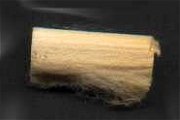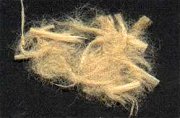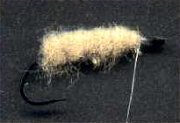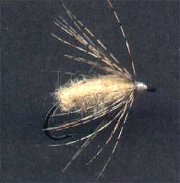 The
Filter Fly is one of the simplest flies to tie. And at times it
is also one of the most effective you can use to catch many kinds
of fish, from trout to bass to bluegills. As you may have guessed
(but perhaps don't want to know) the Filter Fly is tied from dubbing
made from cigarette filters, especially those that have been smoked
and have attained a rich creamy-yellowish hue. (For those who don't
smoke or who object to the use of this material, I provide a list
of substitute materials at the end of this piece).
The
Filter Fly is one of the simplest flies to tie. And at times it
is also one of the most effective you can use to catch many kinds
of fish, from trout to bass to bluegills. As you may have guessed
(but perhaps don't want to know) the Filter Fly is tied from dubbing
made from cigarette filters, especially those that have been smoked
and have attained a rich creamy-yellowish hue. (For those who don't
smoke or who object to the use of this material, I provide a list
of substitute materials at the end of this piece).
It's an unusual material, to be sure. I'm not exactly sure what the material IS — but it's one that is readily available, either in your ashtray if you smoke filtered cigarettes or in someone else's. Or in the gutter or perhaps under a bar stool. If you've got the time and are good at shinnying up a tree, you can even find some in the nests of birds that pick them apart to provide a bit of extra insulation against a harsh winter.
I first learned of the usefulness of this material one summer twenty-five years ago when I was camped at Madison Junction in Yellowstone Park, just below where the Gibbon and the Firehole join to form the Madison. I hadn't much money at the time and was earning what I could by selling flies to passing fishermen, and by selling fish that I caught in the river to the campers at the Junction. This latter activity was,`and probably still is, illegal. Perhaps by today's standards it's considered immoral as well. But that was then and this is now and I really didn't give it much thought at the time.
The deal was this: In the evening, after fishing, I would walk around the various loops in the campground and ask the campers if they'd like a nice fresh fish or two for breakfast in the morning. I usually found a few that were hungry for fresh fish and I would take their orders (and a cash deposit to weed out those who would say "sure" just to get rid of me). In the morning I would walk down to the river and catch four or five of the small (10"-12") rainbows that were plentiful that summer. Then I would clean them by the riverside, put them into my creel, and deliver them to the campers in plenty of time for breakfast.
In the course of cleaning these fish, I often noticed inside their stomachs undigested cigarette filters, probably picked up and eaten when they came across a filter discarded by a fisherman on the stream (this was back when everyone seemed to smoke, remember).
Why they did this was a mystery to me. But I began from that time to experiment with flies tied with used cigarette filters, picking them apart to dub them onto the hook to form simple, fat grub-like flies (that didn't look all different, to tell the truth, from the actual filter before I began to pick it apart, just a bit rougher). These worked quite well and I caught many a nice rainbow on these simple flies.
Later I learned that I could tie up some fairly realistic mayfly and stonefly nymphs out of this material as well. Winding on a fairly thick dubbing and then picking it out, I would then dab a few drops of acetone-thinned head cement onto the back portion of the fly, which melted it somewhat and softened it and allowed me to shape the body however I wanted. When the back portion hardened, I colored it in the appropriate tones with water-resistant art markers. I now had an almost indestructible fly that was partly realistic (the shaped body and painted tones, dark on top light on the bottom) and partly impressionistic (the picked-out fibers to represent legs and tail).
It was only years later that I learned in an article by Robert Boyle and Eric Leiser entitled "The Secret of the White Nymph" that what the fish were taking these filters for was probably an intermediate stage in the life of a stonefly nymph when it loses its coloring and becomes almost albino for a while. At this time, of course, the insect is very vulnerable — and noticeable — and is often gobbled up by the fish.
Whatever the fish take these flies for, take them they do. So go ahead, tie up a few flies with this material — and see if they work for you as well as they worked for me. But whatever you do, don't tell anyone that I was once a "market fisherman." I wouldn't want my reputation sullied. Not only that, but I may have to go back to that way of earning money someday and I wouldn't want my cover blown.
Tying the Filter Fly
This dressing is for the simplest version of the Filter Fly (the grub-like critter). If anyone is interested in the more complex variations, let me know and I'll write them up in a future "issue."
|
Hook: |
Mustad 9571, Partridge K12ST, Tiemco 200R, Daiichi 1560 (really, almost any hook will do), sizes 10 - 12 |
|
Thread: |
Danville's 6/0 or 3/0, cream or white |
|
Body: |
Dubbed cigarette filter (or creamy-white polydubbing or chenille) |
|
Hackle: |
Optional. If used, sparse grizzly or light Partridge |
 Peel wrapper from cigarette filter.
Peel wrapper from cigarette filter.
 Break filter material up with your fingers to make dubbable material.
Break filter material up with your fingers to make dubbable material.
Wind thread onto hook from front to back to form a foundation.
 Dub filter material onto thread and wind from front to back of the shank and then forward again so that you have a thick grub-like body. If desired, rough dubbing up with your fingers or with bodkin to make the body more "buggy."
Dub filter material onto thread and wind from front to back of the shank and then forward again so that you have a thick grub-like body. If desired, rough dubbing up with your fingers or with bodkin to make the body more "buggy."
 Wind on hackle if desired (but sparsely, one turn of hackle only). Whip finish head and then cement it.
Wind on hackle if desired (but sparsely, one turn of hackle only). Whip finish head and then cement it.






